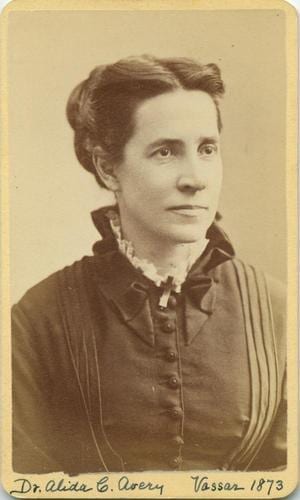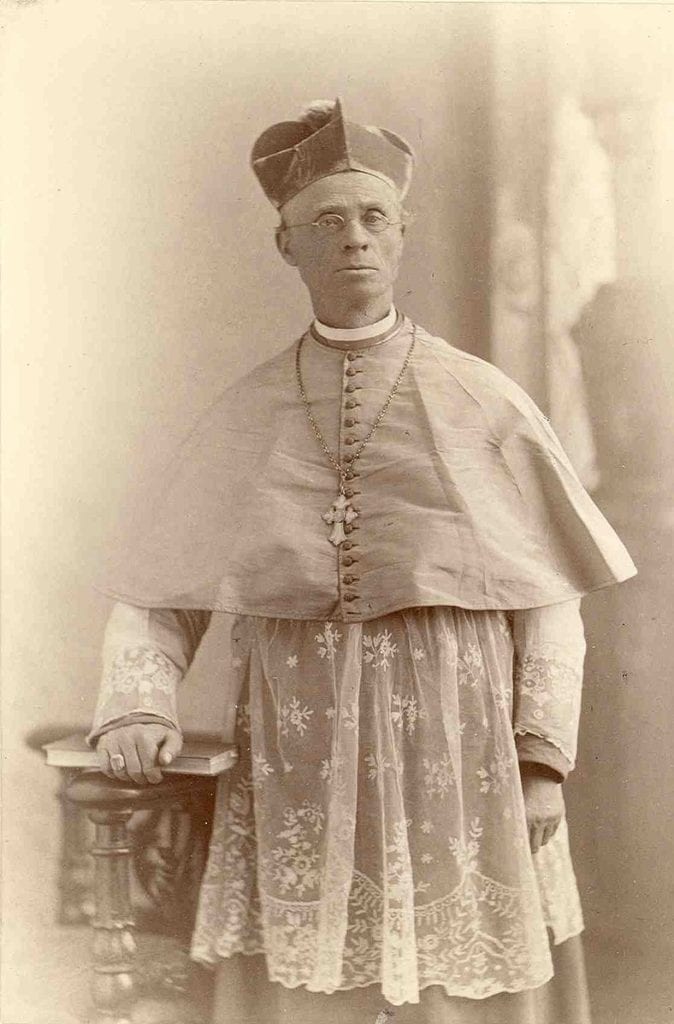Edward McSweegan
Kingston, Rhode, Island, United States
 |
| Doctor Alida C. Avery, Photo courtesy of Archives and Specials Collections/Vassar College Library. Source |
In July 1878, astronomers headed into the American West to observe a total eclipse of the sun. Among them was America’s only woman astronomer, Maria Mitchell of Vassar College, and four of her former astronomy students. Lacking the federal support and discounted railroad tickets of her male colleagues, Mitchell sought Denver housing and a viewing site from her friend and former Vassar colleague, Alida Avery, M.D. Avery lived in a two-story house on the corner of Twentieth and Champa Streets in Denver and assured Mitchell she would have “600 hundred miles” of prairie on which to plant her telescopes.1
Dr. Alida Avery was a rarity in her time: she was a successful, well-paid physician with a national following. But she is remembered less for her medical skills and more for her role as a persistent fever of the body politic in nineteenth-century America.
Her medical education began in 1857 at the Female Medical College of Pennsylvania (later, the Medical College of Pennsylvania). She transferred to Boston’s New England Female Medical College (later merging with Boston University School of Medicine) and graduated in 1862. Over the next few years, she struggled to maintain a profitable private practice in New York. Vassar College opened in 1865, and Avery took a job there as a professor of physiology and resident physician in charge of student health.
Maria Mitchell was the first professor hired by Vassar, and she and Avery became fast friends and life-long allies in the national struggle for equality.2 Ironically, their first fight for equality was with Vassar College. The college paid its male professors $2,000 a year; Mitchell was paid $800 and Avery $700. Protracted negotiations began with the trustees, and letters of resignation were offered by both women. The college eventually made some adjustments to their salaries, but they never equaled the salaries of male professors.
Avery’s next battle had larger consequences. In 1873, a Boston physician, Edward Clarke, published a book entitled Sex in Education; or, A Fair Chance for the Girls. His thesis suggested higher education was detrimental to women because it taxed their brains, lowered maternal instincts, atrophied the reproductive organs, and led to an “Amazonian coarseness.”3 The book found a receptive audience among scientists, physicians, and the larger public. “I grind my teeth in despair over it,” wrote Avery.1
She did not despair for long. The following year Avery joined with other professional women and suffrage activists to produce an aggressive response: Sex and Education. A Reply to Dr. E.H. Clarke’s ‘Sex in Education.’4 Several years later, a women’s organization would extinguish the lingering embers of Clarke’s thesis with hard data. They surveyed 700 Vassar graduates about their past and current health. The Massachusetts Bureau of Statistics of Labor analyzed the data and concluded: “The graduates . . . entered college in good health, passed through the course of study prescribed without material change in health, and since graduation . . . do not seem to have become unfitted to meet the responsibilities . . . of life.”1
Avery also joined with author and feminist Elizabeth Stuart Phelps Ward and other suffragists to rail against the fashionable confinement of women’s steel and whalebone corsets. “Burn up the corsets” was a rallying cry that would echo into the next century and to another generation of women.5
 |
| Catholic Bishop, Joseph P. Machebeuf, Wikipedia. Source |
In 1874, Dr. Avery resigned from Vassar and headed west to the surprisingly liberal territory of Colorado. Six years earlier, the territorial governor had proposed women’s suffrage to the legislature. In 1870, another governor made a similar pitch, noting, “the logic of a progressive civilization leads to the inevitable results of a universal suffrage.”6 Avery opened a private practice in Denver, which likely made her the first woman to practice medicine in the territory. She was elected vice president of the Women’s Suffrage Association of Colorado in 1876 and was appointed Superintendent of Hygiene for Colorado. By 1877, she was earning $10,000 a year. (One hopes she sent a note to the Vassar trustees about her new salary.)
Of Dr. Avery and others like her, Jacqueline Antonovich wrote, “Avery’s dual role as medical practitioner and suffrage activist demonstrates the various ways in which the West symbolized a place where professional and personal aspirations successfully converged for many women doctors. One could more easily establish herself professionally, while also asserting gender equality and political agency.”7
Still, there were professional slights. Avery was denied admission to the Denver Medical Association in 1877; its members persisted in addressing her as “Miss” instead of as “Doctor.” She was admitted four years later, the first of three women admitted to the Denver organization.
Avery worked with Albina Washburn, a Denver newspaper columnist, to lead an 1877 referendum on suffrage. The referendum was Avery’s next great battle. Opposing her was Denver’s Catholic Bishop, Joseph P. Machebeuf. Perhaps the bishop had the unmarried Dr. Avery in mind when he declared “the class of women wanting suffrage are battalions of old maids disappointed in love—women separated from their husbands or divorced by men from their sacred obligations—women who, though married, wish to hold the reins of the family government, for there never was a woman happy in her home who wished for female suffrage.”8 The referendum lost.
Dr. Avery fought on. “I will not yet relinquish my hope, nay, my conviction that Colorado . . . shall be the first to say, ‘My daughters are as free as my sons.’”9 She retired from private practice in 1884 but kept herself immersed in local and national organizations devoted to women and equality. Moving to California in 1887, she served as treasurer of the Susan B. Anthony Club in San Francisco, president of the San Jose Equality Club, treasurer of the Santa Clara County Equal Suffrage Club, and a director of the California Woman Suffrage Association. She was a frequent speaker at suffrage conventions and an occasional contributor to The Woman’s Journal. She wrote, “I have given up medical practice, and busy myself with affairs of general interest. . . .”10
At some point in California, however, she restarted her medical practice. Her 1908 obituary stated she was a San Francisco physician with offices on Larkin Street. Between 1900 and 1904, the city suffered numerous outbreaks of bubonic plague, but there does not seem to be any record of Avery being involved in that infamous public health crisis. The 1906 earthquake put a final end to her medical career.
Dr. Avery may have lost skirmishes with Vassar College, Denver medical societies, and other institutions, but she won the war. In 1931, Avery Hall at Vassar College was named in her honor. In 2019, she was elected to the Colorado Women’s Hall of Fame for her “leadership in securing Colorado women the right to vote [in 1893].”11
In a speech following the failed suffrage referendum in 1877, Dr. Avery told the members of the Colorado Woman Suffrage Association, “We must keep pegging away.”9 Good advice then and now.
References
- Baron D. American Eclipse. New York, NY: Liveright Publishing Co. 2017.
- Rouse W. “Biographical Sketch of Alida Cornelia Avery.” Biographical Database of NAWSA Suffragists, 1890-1920. Available at: https://bit.ly/341kMWQ. Last accessed March 31, 2020.
- Clarke EH. Sex in Education; or, A Fair Chance for the Girls. Boston, MA: Osgood & Co. 1873. Available at: https://bit.ly/2WzmSva. Last accessed: March 22, 2020.
- Howe JW. Sex and Education. A Reply to Dr. E.H. Clarke’s ‘Sex in Education.’ Boston, MA: Roberts Brothers. 1874. Available at: https://bit.ly/2xgLWMS. Last accessed: March 22, 2020.
- Phelps, E. What to Wear. Boston, MA: Osgood & Co. 1873. Available at: https://bit.ly/2UBF9ql. Last accessed April 1, 2020.
- McGraw D. “Dr. Alida Avery: Doctor and Women’s Suffrage Leader.” Prairie Rose Publications. 2017. Available at: https://bit.ly/2UreXxf. Last accessed: March 22, 2020.
- Antonovich J. “Medical Frontiers: Women Physicians and the Politics and Practice of Medicine in the American West, 1870-1930.” 2018.
- Beaton GM. Colorado Women: A History. Louisville, Colo: University Press of Colorado. 2012.
- Avery A. “The President’s Address.” The Woman’s Journal. Feb. 9, 1878, p. 45. Available at: https://iiif.lib.harvard.edu/manifests/view/drs:48859472$51i. Last accessed: March 26, 2020. 10.
- Vassar Encyclopedia. “Alida Avery.” Available at: https://bit.ly/2QBq0Tu. Last accessed: March 22, 2020.
- Skahill M. “The Colorado Women’s Hall of Fame Announces 2020 Class of Inductees.” 2019. Available at: https://bit.ly/2vFBwpA. Last accessed: March 22, 2020.
EDWARD MCSWEEGAN, PhD, is a microbiologist in Rhode Island. He worked at the National Institute of Allergy and Infectious Diseases, and later at the Global Virus Network in Baltimore. He writes frequently about infectious diseases and history.
Winter 2020 | Sections | Women in Medicine

Leave a Reply